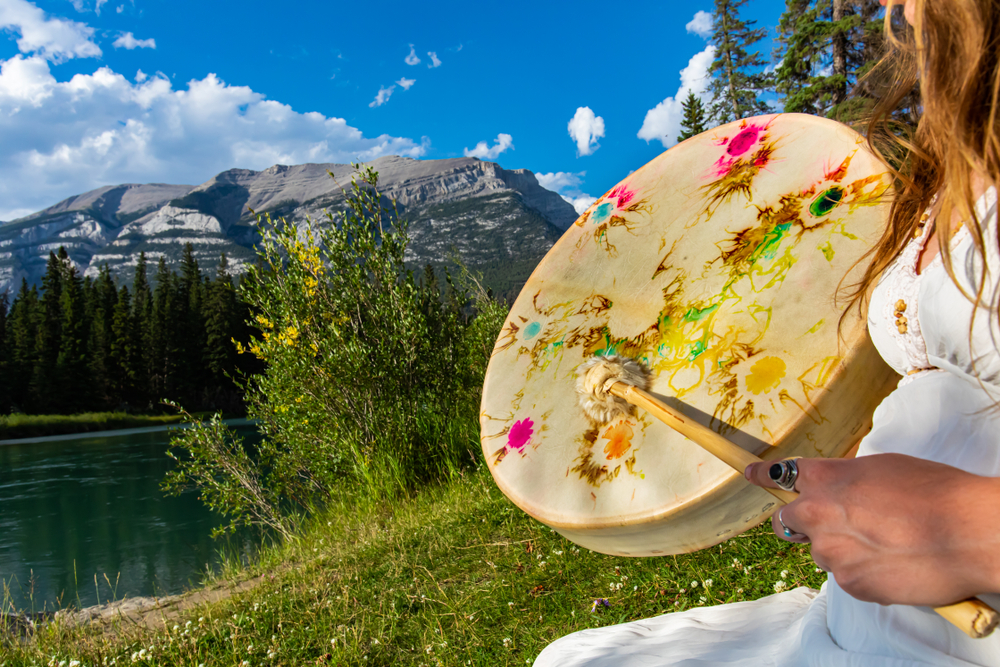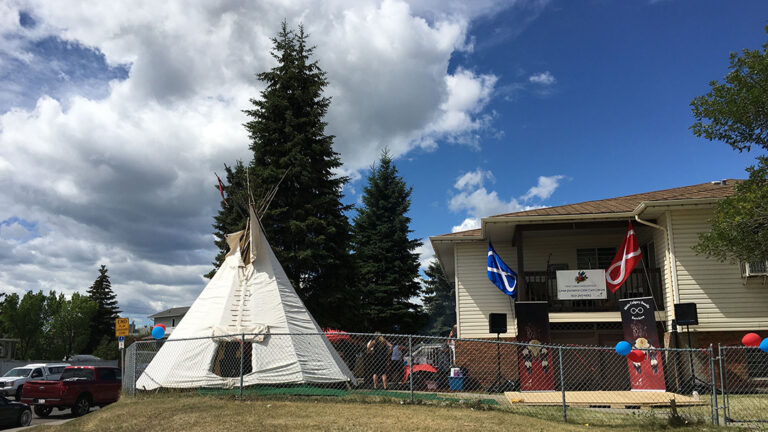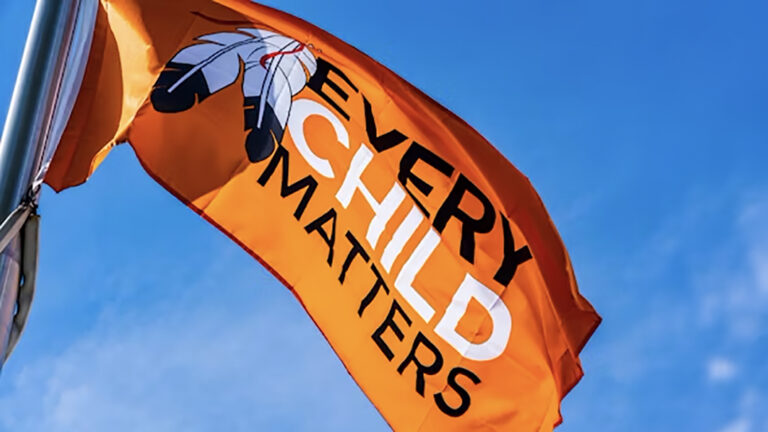A chat with Margaret Pfoh
We recently sat down with Margaret Pfoh, who is Tsimshian from the Eagle Clan of the Gitga’at First Nation, to talk about her thoughts on Indigenous homelessness. Margaret joined the non-profit housing sector 25 years ago and has been the CEO of the Aboriginal Housing Management Association (AHMA) for three years. She also sits on the Community Housing Transformation Centre board of directors. As we near the end of National Indigenous History Month, we wanted to share a few more of her observations with our readers in this edited transcript of our interview.
On cultural dispossession
When you look at the impact of residential schools and the Sixties Scoop—and in today’s era, it is the apprehension of our Indigenous children [through the child welfare system]—it is essentially summed up in the colonization and dispossession of our peoples from our sense of belonging. You start to have an inner battle.
I saw a commercial about a war veteran crossing the street. And he is having this physical fight with himself. Nobody sees it because it is happening in his mind, but he is fighting himself every step of the way.
That is what happens when a person is dispossessed from their sense of belonging, for whatever reason it may be. For me, I was in the care of the ministry from birth. They apprehended me right off the birthing table and would not allow my birth mother to even hold me. My foster family ultimately adopted me, and while I had a fantastic family, a sense of belonging within the family, I always knew that I did not quite fit in.
In one way or another, in the first few years, when you have a strong family that raises you, like you are one of every other child in the family, you are not aware necessarily of the reality that you don’t fit in. I didn’t know I wasn’t white until I got old enough to be teased and be called racist names. Like you squaw, you dirty little Indian and, you know, when that awareness starts to kick in, you start to think “Well, I don’t belong here, then.”
And so, you become like that veteran in that commercial, you’re having that war within yourself all the time.
I read a report about a month ago that there are currently more Indigenous children in care than there ever was in residential schools. Which is a profound statement on the future of our population.
On cultural safety
I talked to a transition home [staff member] in Williams Lake [B.C.] about [cultural safety] and she said to me “you know, when we [operate] our shelters as an Indigenous organization, our transition homes and our shelters have cultural identifying artifacts, readily visible so that when an Indigenous woman comes to this transition home, the first thing she sees is a dream catcher or a star blanket or, you know, some sort of demonstration that this organization practices and implements cultural safety.”
It sounds simplistic, but that is the core of For Indigenous, By Indigenous. [For Indigenous, By Indigenous, or FIBI, is essentially an Indigenous-led call to action for a comprehensive housing strategy that includes the 80% of Indigenous households who live away from reserves. It is designed to eliminate the gap in “core housing need” faced by Indigenous peoples, especially in Canada’s north.]
By the nature of being from the same cultural background, even if we are dispossessed from that culture, the fact that I have walked that journey, the fact that you have walked that journey, you know, there is that battle of belonging because you are not visible in the majority population. And so being able to allocate capital and staffing resources to Indigenous service providers is one less barrier for our communities that are battling homelessness, because it’s emotional, it’s spiritual, it’s cultural. And it’s just [one less barrier] they have to battle before they start addressing [anything else].

For Indigenous, By Indigenous
I think that the real battle is this issue of control. I think that, and this is where I argue with all levels of government [so they] understand, For Indigenous, By Indigenous means it’s not enough for you to simply throw around your privilege with benevolence, [especially] when you’re missing the concept of cultural safety.
[For example,] I was going to battle, here in the city of Mission [B.C.], for a development permit to build one of our Indigenous housing complexes—and [city officials] didn’t get it.
Exactly as you’re asking a majority non-Indigenous community, with a whole mayor and council of older white males, trying to explain to them that the creation of an Indigenous housing facility for Indigenous community is essential to removing barriers for Indigenous people, and they didn’t get that.
They were all like “well, you’re just creating ghettos.” That was their fear and their response, [that] by putting all these poor Indians together, we are going to create a ghetto. Well, how judgmental and stereotypical of them to even think that!
[And] it’s the crux of what the Canadian Housing Renewal Association’s Indigenous Caucus has been doing. It’s about that whole For Indigenous, By Indigenous argument that if we have Indigenous housing providers in an area and if the target population is Indigenous, we need to be having those Indigenous leaders at the table, helping draw the solutions.
On systemic barriers
Zoning is a big issue because it has been structured to allow for economic prosperity, which still largely feeds a white capitalist community sentiment.
Why should I build my Indigenous housing program for our community five kilometres from the city centre, when most of our community doesn’t own a car, and how are they going to get to their jobs? How are they going to get to their school? How are they going to get there?
I heard this story [about] a mother who could not find safe housing in the city of Smithers [B.C.]. Her child was apprehended [by the child welfare system] and held in Smithers, but the mother can’t afford rent anywhere except Houston. So, she’s now an hour [66 kilometres] away. She has to hitchhike to get back to Smithers in order to meet her family reconciliation strategy, to do these interviews, to try to get a job.
And it’s not an hour on a metro train, it’s not an hour on a bus because there are no buses and there is no Metro train. We are talking about an hour down a wooded, forested highway where our women and girls have gone missing again [and again], just look at the Highway of Tears. She has to hitchhike to get back to Smithers.
The system structures so many things without understanding these systemic barriers that are already in place for marginalized people [it often drives people further into poverty]. The very systemic barriers for marginalized communities are so ingrained, right down to zoning, right down to infrastructure.
And when we start to look at things through that lens, the whole concept of economic reconciliation is also huge. To start understanding how the system structures and marginalizes our communities.
On mistrust surrounding COVID-19 vaccination
From people with good education, good income, good stability to our homeless population, one common thread is that genuine fear [of COVID-19 vaccination].
You hear about it in the residential schools, you hear about it in the ‘60s: they were using Indigenous children as test subjects around new basic issues like nutrition and vaccinations. Even myself, I had a moment’s doubt about whether I have been a test subject.
[Regardless] I got vaccinated. I have talked to many leaders who had initial resistance to it as well. My media person tweeted [about] my vaccination and other Indigenous leaders have gone and publicly demonstrated their vaccinations.
We are working to overcome those fears and those barriers, because if we are having them within our position of privilege—and I say that being educated, employed—imagine a homeless person having these questions and doubts and the barriers they are fighting before they even walk in to get that vaccine.
There is a need for Indigenous leaders to demonstrate that this is greater than anything like that [fear]. It is about protecting ourselves. It is about protecting our communities. It is about understanding that we have a higher rate of serious respiratory issues. And this vaccination could save your life.



